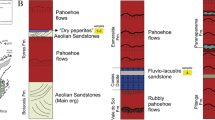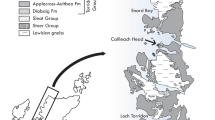Abstract
Although the notion of an early origin and diversification of life on Earth during the Archaean eon has received increasing support in geochemical, sedimentological and palaeontological evidence, ambiguities and controversies persist regarding the biogenicity and syngeneity of the record older than Late Archaean1,2,3. Non-biological processes are known to produce morphologies similar to some microfossils4,5, and hydrothermal fluids have the potential to produce abiotic organic compounds with depleted carbon isotope values6, making it difficult to establish unambiguous traces of life. Here we report the discovery of a population of large (up to about 300 μm in diameter) carbonaceous spheroidal microstructures in Mesoarchaean shales and siltstones of the Moodies Group, South Africa, the Earth’s oldest siliciclastic alluvial to tidal-estuarine deposits7. These microstructures are interpreted as organic-walled microfossils on the basis of petrographic and geochemical evidence for their endogenicity and syngeneity, their carbonaceous composition, cellular morphology and ultrastructure, occurrence in populations, taphonomic features of soft wall deformation, and the geological context plausible for life, as well as a lack of abiotic explanation falsifying a biological origin. These are the oldest and largest Archaean organic-walled spheroidal microfossils reported so far. Our observations suggest that relatively large microorganisms cohabited with earlier reported benthic microbial mats8 in the photic zone of marginal marine siliciclastic environments 3.2 billion years ago.
This is a preview of subscription content, access via your institution
Access options
Subscribe to this journal
Receive 51 print issues and online access
$199.00 per year
only $3.90 per issue
Buy this article
- Purchase on Springer Link
- Instant access to full article PDF
Prices may be subject to local taxes which are calculated during checkout



Similar content being viewed by others
References
Buick, R. in Paleobiology II (eds Briggs, D.E.G. & Crowther, P.R.) 13–21 (Blackwell Science, 2001)
Schopf, J. W. Fossil evidence of Archaean life. Phil. Trans. R. Soc. B 361, 869–886 (2006)
Rasmussen, B., Fletcher, I. R., Brocks, J. J. & Kilburn, M. R. Reassessing the first appearance of eukaryotes and cyanobacteria. Nature 455, 1101–1105 (2008)
Garcıa-Ruiz, J. M. et al. Self-assembled silica-carbonate structures and detection of ancient microfossils. Science 302, 1194–1197 (2003)
Brasier, M. D. M. c. L. o. u. g. h. i. n. N., Green, O. & Wacey, D. A fresh look at the fossil evidence for early Archaean cellular life. Phil. Trans. R. Soc. B 361, 887–902 (2006)
McCollom, T. M. & Seawald, J. S. Carbon isotope composition of organic compounds produced by abiotic synthesis under hydrothermal conditions. Earth Planet. Sci. Lett. 243, 74–84 (2006)
Eriksson, K. A. & Simpson, E. L. Quantifying the oldest tidal record: the 3.2 Ga Moodies Group, Barberton Greenstone Belt, South Africa. Geology 28, 831–834 (2000)
Noffke, N., Eriksson, K. A., Hazen, R. M. & Simpson, E. L. A new window into Early Archean life: microbial mats in Earth’s oldest siliciclatic tidal deposits (3.2 Ga Moodies Group, South Africa). Geology 34, 253–256 (2006)
Pflug, H. D. Structured organic remains from the Fig Tree Series (Precambrian) of the Barberton mountain land (South Africa). Rev. Palaeobot. Palynol. 5, 9–29 (1967)
Altermann, W. The oldest fossils of Africa—a brief reappraisal of reports from the Archean. J. Afr. Earth Sci. 33, 427–436 (2001)
Noffke, N., Beukes, N., Bower, D., Hazen, R. M. & Swift, D. J. P. An actualistic perspective into Archean worlds—(cyano-)bacterially induced sedimentary structures in the siliciclastic Nhlazatse Section, 2.9 Ga Pongola Supergroup, South Africa. Geobiology 6, 5–20 (2008)
Tice, M. M. & Lowe, D. R. Photosynthetic microbial mats in the 3.416-Myr-old ocean. Nature 431, 549–552 (2004)
Javaux, E. J., Knoll, A. H. & Walter, M. R. TEM evidence for eukaryotic diversity in mid-Proterozoic oceans. Geobiology 2, 121–132 (2004)
Knoll, A. H., Javaux, E. J., Hewitt, D. & Cohen, P. Eukaryotic organisms in Proterozoic oceans. Phil. Trans. R. Soc. B 361, 1023–1038 (2006)
Heubeck, C. & Lowe, D. R. Depositional and tectonic setting of the Archean Moodies Group, Barberton Greenstone Belt, South Africa. Precambr. Res. 68, 257–290 (1994)
Kamo, S. L. & Davis, D. W. Reassessment of Archean foredeep sedimentation related to crustal shortening: a reinterpretation of the Barberton Mountain Land, South Africa, based on U–Pb dating. Tectonics 13, 167–192 (1994)
Butterfield, N. J., Knoll, A. H. & Swett, N. Paleobiology of the Neoproterozoic Svanbergfjellet formation, Spitsbergen. Fossils Strata 34, 1–84 (1994)
Tice, M. M., Bostick, B. C. & Lowe, D. R. Thermal history of the 3.5–3.2 Ga Onverwacht and Fig Tree Groups, Barberton greenstone belt, South Africa, inferred by Raman microspectroscopy of carbonaceous material. Geology 32, 37–40 (2004)
Marshall, C. P. et al. Structural characterization of kerogen in 3.4 Ga Archaean cherts from the Pilbara Craton, Western Australia. Precambr. Res. 155, 1–23 (2007)
Pasteris, J. D. & Wopencka, B. Necessary, but not sufficient: Raman identification of disordered carbon as a signature of ancient life. Astrobiology 3, 727–738 (2003)
Strauss, H. & Moore, T. B. in The Proterozoic Biosphere: a Multidisciplinary Study (eds Schopf, J.W. & Klein, C.) 709–798 (Cambridge Univ. Press, 1992)
Deamer, D., Singaram, S., Rajamani, S., Kompanichenko, V. & Guggenheim, S. Self-assembly processes in the prebiotic environment. Phil. Trans. R. Soc. B 361, 1809–1818 (2006)
Akashi, K.-I., Miyata, H., Itoh, H. & Kinosita, K. Preparation of giant liposomes in physiological conditions and their characterization under an optical microscope. Biophys. J. 71, 3242–3250 (1996)
Van Zuilen, M. A., Chaussidon, M., Rollion-Bard, C. & Marty, B. Carbonaceous cherts of the Barberton Greenstone Belt, South Africa: isotopic, chemical and structural characteristics of individual microstructures. Geochim. Cosmochim. Acta 71, 655–669 (2007)
Jones, B. & Renaut, R. W. Microstructural changes accompanying the opal-A to opal-CT transition: new evidence from the siliceous sinters of Geysir, Haukadalur, Iceland. Sedimentology 54, 921–948 (2007)
Walsh, M. M. Microfossils and possible microfossils from the early Archean Onverwacht Group, Barberton Mountain Land, South Africa. Precambr. Res. 54, 271–292 (1992)
Sugitani, K. et al. Diverse microstructures from Archaean chert from the Mount Goldsworthy–Mount Grant area, Pilbara Craton, Western Australia: microfossils, dubiofossils, or pseudofossils? Precambr. Res. 158, 228–262 (2007)
Dworkin, M., Falkow, S., Rosenberg, E., Schleifer, K.-H., Stackebrandts, E. eds. in The Prokaryotes 3rd edn, Vol. 6, 1156–1163; Vol. 7, 31–115 (Springer, 2006)
Waterbury, J. B. & Stanier, R. Y. Patterns of growth and development in Pleurocapsalean cyanobacteria. Microbiol. Rev. 42, 2–44 (1978)
Bekker, A. et al. Dating the rise of atmospheric oxygen. Nature 427, 117–120 (2004)
Acknowledgements
We thank M. Giraldo, J. Laval and N. Decloux for sample preparation; P. Compère for TEM imaging; C. Henrist for environmental SEM imaging and energy-dispersive X-ray analyses; T. Prokopiuk for carbon isotope analyses; J. Robertson for information on geology of the Agnes Gold Mine; and A. H. Knoll for comments on an earlier version of the manuscript. The study was supported by a University of Liège Impulsion Grant (CFRA0805) and a University of Liège grant (RCFRA0036-J) to E.J., a National Science Foundation grant (EAR-937 05-45484), a NASA Astrobiology Institute award (NNA04CC09A), a Natural Sciences and Engineering Research Council of Canada 938 Discovery grant to A.B., and Australian Research Council funding to C.M.
Author Contributions E.J. and A.B. conceived the study and wrote the paper. E.J. discovered the microfossils and performed the microscopic, SEM and TEM analyses, and interpreted the data. C.M. performed the Raman analyses and interpreted and wrote the results. A.B. conducted field work and carbon isotope analyses and interpreted the sedimentary structures. All authors commented on the manuscript.
Author information
Authors and Affiliations
Corresponding author
Ethics declarations
Competing interests
The authors declare no competing financial interests.
Supplementary information
Supplementary Information
This file contains Supplementary Figures 1-2 with Legends, Supplementary Table 1 and Supplementary Notes. (PDF 1101 kb)
Rights and permissions
About this article
Cite this article
Javaux, E., Marshall, C. & Bekker, A. Organic-walled microfossils in 3.2-billion-year-old shallow-marine siliciclastic deposits. Nature 463, 934–938 (2010). https://doi.org/10.1038/nature08793
Received:
Accepted:
Published:
Issue Date:
DOI: https://doi.org/10.1038/nature08793
This article is cited by
Comments
By submitting a comment you agree to abide by our Terms and Community Guidelines. If you find something abusive or that does not comply with our terms or guidelines please flag it as inappropriate.



